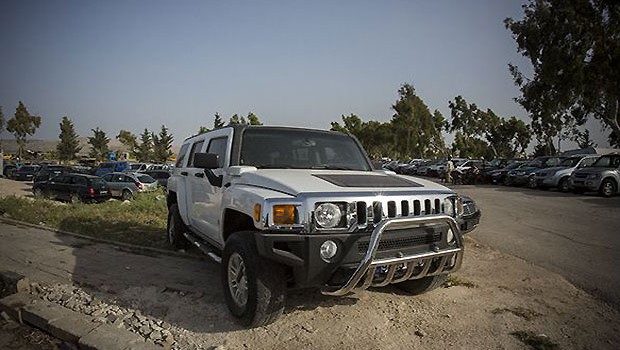“I’m selling about seven cars a month,” says Ibrahim. “BMWs, Audis and a lot of Mazdas, but mostly 4x4s.” His latest deal was sealed yesterday—a Ford 4×4 that he sold for $9,000. He says he doesn’t know who bought it, but most of his customers are the rebel fighters who emblazon the back windscreens of their new cars with ‘Allahu Akhbar’ and the front with three starred flag of the revolution. The cars here are rebel status symbols as much as they are necessities. “There weren’t a lot of foreign cars in Syria before the revolution,” he says. “But now they’re what everybody wants. No-one wants to drive a Syrian car any more.”
He has thirty cars for sale at the moment, but there are twenty-five other vendors like Ibrahim at the market and well over a thousand cars altogether. Some have Bulgarian or Romanian license plates and some have no license plates at all, but Ibrahim insists that every car he sells is legitimate. “Most come from Europe but they have to come through Bulgaria or Romania to pass through the Turkish border,” he explains. “I won’t sell a car that doesn’t have a full set of papers.” Most come from the European Union, including some from the UK.
The market sprawls over a huge patch of open grassland that used to be a park. In the middle there’s a clearing, a makeshift mosque in a tent, and a family of sheep grazing next to a shining and pristine Ford Mustang. Ibrahim asks me not to reveal the exact location—“every time somewhere appears in the newspapers it is bombed soon afterwards”—and describes an airstrike two weeks ago that destroyed two of his cars. “We all run and take cover when the jets come, because if a bomb falls in the middle of the cars it will be a disaster,” he says. “The whole market will explode.”
The market has been here for just four months, servicing a growing demand for imported cars fueled by the needs of the opposition fighters, and only possible because Syria’s once closed economy has been suddenly freed in some of the areas controlled by the rebels. War creates its own kind of economy, and the uprising has opened the way for a new breed of entrepreneurs like Ibrahim.
“There have always been car traders in this area,” he says. “But before the uprising they’d sell one or two, and they’d do it discreetly.” There is nothing discreet about the car market now. The vendors park their best stock right next to the road to draw the customers in, and happily offer test drives and cups of tea in the hope of making a big sale. “I can sell you the Hummer for $25,000,” says one. “That’s got to be a better deal than you can get in the UK.”
It’s also a better deal than his Syrian customers are used to. “The cars you see here used to cost three times as much as they do now,” Ibrahim says. “Like this Toyota Land Cruiser. I can sell you it for $13,000, but before the uprising it would have cost you $40,000.” With the previously sky-high import taxes no longer enforced, luxury cars are now available to people who could once only dream of driving them. “Only the regime’s elite had these cars in Syria before,” says Ibrahim. “Now anyone can have one, and so everyone wants one.” But most people in Syria still can’t afford these cars, even if they are a being offered at a bargain price. The customers browsing the parked rows are almost exclusively dressed in combat fatigues.
Ibrahim has built his business on the back of the war, but that means that he is susceptible to its volatility. In recent days the Syrian Lira has fallen sharply against the dollar, slashing the profit that he makes on each car. “Before I’d make around $300 on each car I sold,” he says, “but now I’ll accept $150.” But when the border crossings with Turkey are closed—as they are on the day I meet him—his business picks up. “It’s good for us when the border is closed because it means that people can’t go out to Turkey to buy their cars. They have to come to us.”
But despite his trade, Ibrahim doesn’t drive a car himself. “The cars from Europe are such poor quality,” he says. “Once I bought a hundred cars and all of them needed repairing. After what I’ve seen here, I’ll never buy a European car.”

